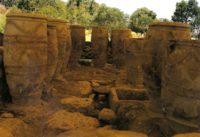Gortyn was first inhabited at the end of the Neolithic period (3000 B.C.) and flourished much later, in the Late Minoan period (1600-1100 B.C.), when the villa with the shrine was founded at the site of Kannia, near Mitropolis.


The villa at Kannia
Remains of the Archaic habitation (7th century B.C.) were located in the area of the Acropolis, while the large inscription, the Gortyn Law Code, dated to the 5th century B.C., attests the prosperity of the city, which continued until the Hellenistic period (3rd-2nd century B.C.).
Gortyn became an ally of Rome and during the Roman period (1st-5th centuries A.D.) reached the peak of its prosperity as the capital of the province of Crete and Cyrene. Here, Apostle Titus preached Christianity and in A.D. 250 the Ten Saints martyred. In A.D. 824 the city, which had become the seat of an Archbishop, was destroyed by the Arabs.
Historical, Economic, Social and Urban planning at Gortyn in the period of the Great Inscription
The Great Inscription offers important evidence on developments in the city of Gortyn itself. It seems that at the end of the 6th century, the cities of Crete were actively organized by the abridgment of their laws into codes like the Gortyn Code .At Gortyn itself, the period circa 500 B.C. was a transitional period fron an earlier economic and social system to a new one which led to the creation of the city-state and to the change of its urban planning and organization.
During the centuries preceding the Inscription, in addition to the Agora there was the upper city located on the Acropolis and on the hills north of the Agora. The lower city, which was spread in the valley, included scattered small towns (komae) interposed between agricultural areas. The names of these small towns, as they have survived in other inscription, are Latosion, Hermaion and Pythion, possibly based on the sanctuaries of their deities.
In the period of the Inscription, the city had begun to obtain a planning unity and it appears to be planned in a unified structure. The function of the Agora as a meeting place and as a place where speeches were made , adoptions were carried out and slaves were sold etc., explains the importance of this new political structure of the city. Of the same interest is the information mentioned in the Inscription about houses in the city and houses in the countryside.
It could be supported therefore , that the codification of Gortyn' s legislation, during the first half of the 5th century, is the first and, possibly, the most important political reform, according to which the Agora , which was responsible for the legislation, was the centre of all the city's activities.